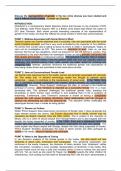Discuss the representation of gender in the two crime dramas you have studied and
how it reflects social context. (Liesbet van Zoonen)
INTRODUCTION:
Hinterland is a contemporary Welsh detective drama that focuses on the character of DCI
Tom Mathias, while Prime Suspect 1991 is a British crime drama that follows the career of
DCI Jane Tennison. Both shows provide interesting examples of the representation of
gender in the media, and how this reflects the social context in which they were produced.
POINT 1. Mathias Associated with Social World of Work
Theorist Liesbet van Zoonen observes how in a society, men are associated with the social
world of politics and work, and this is very much embodied by the character of Tom Mathias.
He comes from London and is willing to leave his home to settle in Aberystwyth, Wales, to
carry out an investigation as DCI. This proves his dedication to work. Later on, we also
discover that he has two daughters, whom we presume he has left behind in London. This
commitment to his work illustrates the stereotype of men as being primarily concerned with
their careers and success in professional settings. This portrayal of gender roles in media is
rooted in social contexts where it was the general belief that men are naturally suited for
leadership and decision-making roles, while women are better suited for nurturing and
caregiving roles. Mathias' character reinforces the traditional gender role expectations of
men being career-driven and committed to their work above all else.
POINT 2. Jane as Unconventional Female Lead
van Zoonen also observes how in the media, women are generally associated with domestic
life. She states that, ‘in feminist terminology media are thought to transmit sexist,
patriarchal… values to contribute to the maintenance of social order’. In the 1990s, there
was a persistent societal expectation that women should primarily be associated with
domestic life. However, ‘Prime Suspect’ challenges this idea. In contrast to the traditional
portrayal of women, Jane Tennison is depicted as a successful female DCI in a male-
dominated field. This portrayal challenges the traditional gender roles, breaking the
boundaries in which women were confined in and enabling them to be in positions of
leadership. Furthermore, Jane Tennison's character is shown as having a complicated
personal life, with issues including alcoholism, failed relationships, and her struggle to
balance her demanding job with her personal life. This depiction further challenges the
stereotyped female roles in media as being perfect.
POINT 3: Women as Victims
Whilst ‘Prime Suspect’ does resist some conventions of female roles, it does perpetuate the
trope wherein women are victims. van Zoonen discusses how in media, women may not
necessary be absent, however, they are often victims. This is evident in the character of
Moyra, who is a victim of sexual assault from George Marlow and is also trapped with him
despite him being suspected of murder. In the 1990s, there was a widespread belief that
women who were victims of rape were somehow responsible for their own assault. This
could explain why Moyra stayed with George, despite him then being suspected of murder.
‘Prime Suspect’ therefore perpetuates the trope in which women are often portrayed as
victims in the media. Moyra is helpless and vulnerable.
POINT 4: Helen is the Opposite of Caring
In van Zoonen’s analysis of the female gender in the media, she also points out how
femininity is about care, nurturance and compassion. This gendered expectation was
reinforced in the media. However, the character of Helen Jenkins, from ‘Hinterland’, defies
this convention, revealing a more complex representation of femininity in the media. She
favoured Hywel since he was a child and invested plenty of time to nurture him and bond
with him. Yet, as much as she cared for Hywel, her brutality towards the other children for
misbehaviour, from pulling out their teeth to threatening them with the devil, demonstrates a




